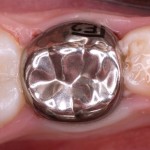
While preventable caries remains one of the commonest disease in the world and a significant worldwide public health problem. It affects over 600 million children and restoration of the primary teeth is one of the commonest procedures performed by dentists. A range of materials are available including composites, glass ionomer cements, and steel crowns but there is little published information of the comparative longevity of these restorations.
The aim of this review was to investigate the longevity of posterior restorations of primary teeth using different materials.
Methods
Searches were conducted in the SciVerse Scopus, ISIS Web of Science, Cochrane library and Medline/PubMed databases. References of eligible studies were screened and crosschecked. Two reviewers independently screened studies, abstracted data and assessed risk of bias.
Longitudinal clinical studies (prospective, retrospective, and randomized clinical trials) evaluating restorations (class I, class II, and crown) placed in primary teeth with composite, amalgam, compomer, glass ionomer cements, stainless steel crown (SSC), resin- modified glass ionomer cements (RMGIC), and metal-reinforced glass ionomer cement (MRGIC) were considered. The main outcome was longevity of restorations presented as annual failure rate (AFR), survival rate, or success rate.
Results
- 31 studies were included
- 14 of the studies were RCTs (9 split mouth, 5 parallel)
- all the studies were considered to be at high risk of bias.
- Follow up ranged from 1-4 years.
- The overall failure rate was 12.5%.
- Class I restorations and restorations placed using rubber dam had better AFRs.
- The main reason for failure was secondary caries (36.5%).
| Material | No. of Studies | No of Restorations | Overall AFR (%) | Total success rate (%) |
| Amalgam | 6 | 2360 | 1.0-28.0 | 82.0 |
| Composite | 6 | 2266 | 1.7-12.9 | 79.3 |
| Conventional GIC | 5 | 639 | 0.8-16.6 | 88.7 |
| Compomer | 9 | 1723 | 1.7-15.4 | 91.2 |
| RMGIC | 10 | 3689 | 0.9-16.9 | 93.6 |
| MRGIC | 4 | 256 | 10.0-29.9 | 57.4 |
| SSC | 3 | 1114 | 1.4-19.0 | 96.1 |
Conclusions
The authors concluded: –
there is a large variation in longevity of posterior restorations in primary teeth. Composite resin exhibited the lowest AFRs, whereas MRGIC exhibited the highest. SSC had the highest success rate. Higher success rates were observed in restorations of a single tooth surface and those performed with rubber dam isolation. Secondary caries was the main reason for failure.
Comments
The authors have searched a number of databases identifying 31 studies. While just under half of the studies are randomised (14) all the studies were considered to be at high risk of bias. The data from all the included studies is well tabulated but it is not easy to identify which of the included studies is retrospective. Given that only 5 of the included studies were retrospective and the these are at higher risk of bias is would have been interesting to see what effect would have been the impact of removing these from the calculations. Focusing on just the included RCTs might also have been considered. The authors present a calculated AFR and there is limited information on how this was done and if they made any formal calculation from study drop outs.
Is is worth noting that recent Cochrane review by Innes et al (Dental Elf – 6th Jan 2016) included 5 RCTs compared with the 3 included on SSCs in this review also finding them to be effective in managing decay in primary teeth. Currently a Cochrane review is underway looking at restorations for primary teeth (Weldon et al).
Links
Primary Paper
Chisini LA, Collares K, Cademartori MG, de Oliveira LJC, Conde MCM, Demarco FF, Corrêa MB. Restorations in primary teeth: a systematic review on survival and reasons for failures. Int J Paediatr Dent. 2018 Jan 10. doi: 10.1111/ipd.12346. [Epub ahead of print] Review. PubMed PMID: 29322626.
Other references
Dental Elf – 6th Jan 2016
Crowns more effective than fillings for decay in primary molar teeth
Weldon JC, Yengopal V, Siegfried N, Gostemeyer G, Schwendicke F, Worthington HV. Dental filling materials for managing carious lesions in the primary dentition (Protocol). Cochrane Database of Systematic Reviews 2016, Issue 9. Art. No.: CD012338. DOI: 10.1002/14651858.CD012338.

[…] Primary teeth: which restorative material last longer? […]